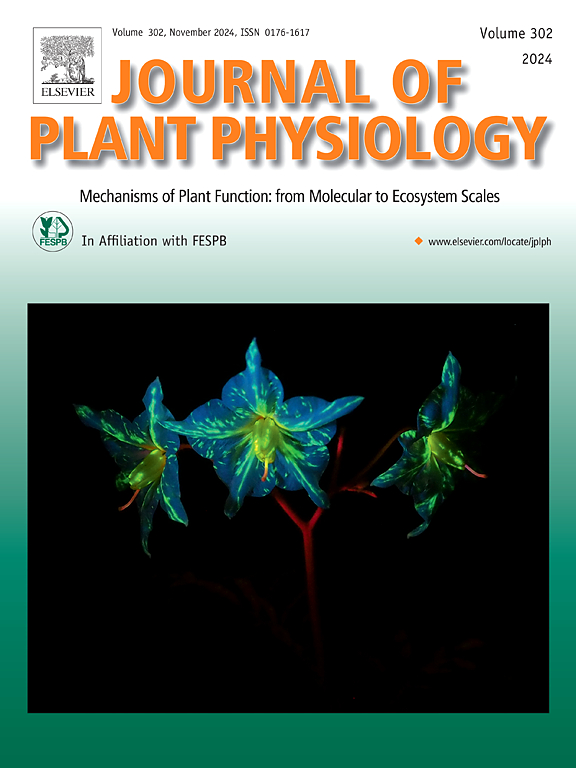PQ池的氧化还原状态是否参与调节CAM兼性半盐生植物的ET生物合成途径?
IF 4.1
3区 生物学
Q1 PLANT SCIENCES
引用次数: 0
摘要
调节乙烯(ET)生物合成及其作用的机制和因素在很大程度上尚未被探索,特别是在cam兼性和(半)盐生植物中。利用冰植物Mesembryanthemum crystallinum L.提供了一个独特的机会来同时研究半盐植物和cam -兼性植物中质体醌(PQ) - ET的相互作用。在这里,我们展示了对普通冰植物对长时间(14天)盐度胁迫和DCMU的反应的分析结果,DCMU使PQ池处于更氧化的状态,从而模拟黑暗条件。差异表达基因(DEG)分析显示,应用DCMU后,参与ET调控的基因的表达没有显著改变。然而,在不受盐胁迫影响的C3植物中,DCMU对光系统、光合作用和光合电子传递链相关基因的表达均有显著影响。我们认为,持续的盐度胁迫和CAM光合作用的发生使得生理过程对PQ池氧化还原状态的改变造成的破坏不敏感。对ET生物合成途径中心中间体-1-氨基环丙烷-1-羧酸(ACC)的UPLC-MS分析证实了分子分析结果,因为ACC含量在未处理和处理的植物中受到相似的影响。此外,对过氧化氢酶和超氧化物歧化酶等关键抗氧化系统组分的分析表明,PQ池氧化还原状态并没有直接调节它们。相反,人们提出了另一种涉及活性氧(ROS)积累和ROS诱导的信号级联的调节机制。本文章由计算机程序翻译,如有差异,请以英文原文为准。
Is the redox state of the PQ pool involved in regulating the ET biosynthesis pathway of CAM facultative semi-halophytes?
The mechanisms and factors regulating ethylene (ET) biosynthesis and its action remain largely unexplored, particularly in CAM-facultative and (semi)halophytic plants. The use of Mesembryanthemum crystallinum L. (ice plant) provides a unique opportunity to examine plastoquinone (PQ) - ET interactions in semi-halophytes and CAM-facultative plants simultaneously. Here, we present the results of an analysis of the common ice plant's response to prolonged (14-day) salinity stress and DCMU, which maintains the PQ pool in a more oxidised state, thereby mimicking darkness conditions. Differentially expressed gene (DEG) analysis showed that the expression of genes involved in ET regulation was not significantly altered after DCMU application. However, in C3 plants not affected by salinity stress, the expression of genes related to both photosystems, photosynthesis, and the photosynthetic electron transport chain was significantly affected by DCMU. We propose that sustained salinity stress and the occurrence of CAM photosynthesis render physiological processes insensitive to disruptions caused by a modified PQ pool redox state. The UPLC-MS analysis of the ET biosynthesis pathway central intermediate – 1-aminocyclopropane-1-carboxylic acid (ACC) – confirmed the molecular analysis results, as ACC content was similarly affected in salinity untreated and treated plants. Moreover, the analysis of key antioxidative system components, namely catalase and superoxide dismutases, suggests that PQ pool redox state does not directly regulate them. Instead, an alternative regulation mechanism involving reactive oxygen species (ROS) accumulation and a ROS-induced signalling cascade has been proposed.
求助全文
通过发布文献求助,成功后即可免费获取论文全文。
去求助
来源期刊

Journal of plant physiology
生物-植物科学
CiteScore
7.20
自引率
4.70%
发文量
196
审稿时长
32 days
期刊介绍:
The Journal of Plant Physiology is a broad-spectrum journal that welcomes high-quality submissions in all major areas of plant physiology, including plant biochemistry, functional biotechnology, computational and synthetic plant biology, growth and development, photosynthesis and respiration, transport and translocation, plant-microbe interactions, biotic and abiotic stress. Studies are welcome at all levels of integration ranging from molecules and cells to organisms and their environments and are expected to use state-of-the-art methodologies. Pure gene expression studies are not within the focus of our journal. To be considered for publication, papers must significantly contribute to the mechanistic understanding of physiological processes, and not be merely descriptive, or confirmatory of previous results. We encourage the submission of papers that explore the physiology of non-model as well as accepted model species and those that bridge basic and applied research. For instance, studies on agricultural plants that show new physiological mechanisms to improve agricultural efficiency are welcome. Studies performed under uncontrolled situations (e.g. field conditions) not providing mechanistic insight will not be considered for publication.
The Journal of Plant Physiology publishes several types of articles: Original Research Articles, Reviews, Perspectives Articles, and Short Communications. Reviews and Perspectives will be solicited by the Editors; unsolicited reviews are also welcome but only from authors with a strong track record in the field of the review. Original research papers comprise the majority of published contributions.
 求助内容:
求助内容: 应助结果提醒方式:
应助结果提醒方式:


